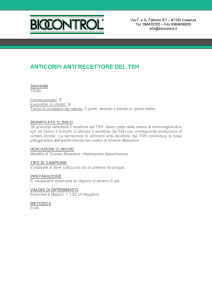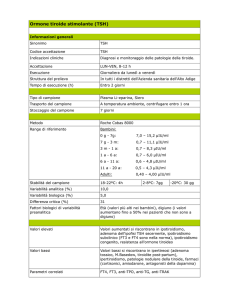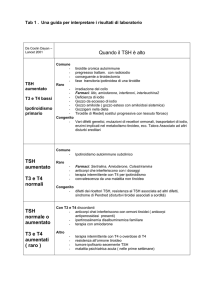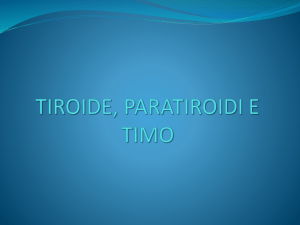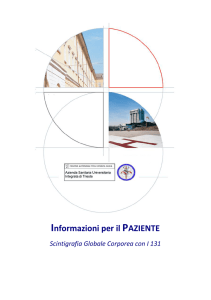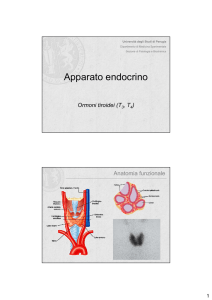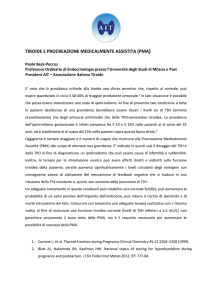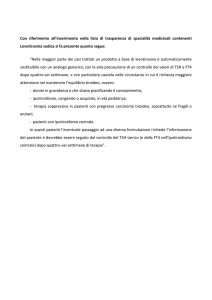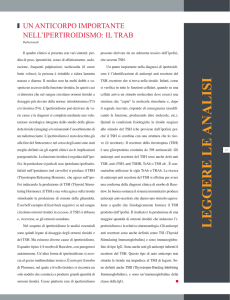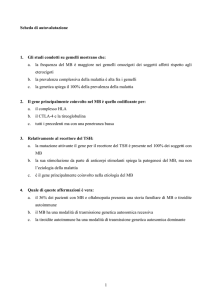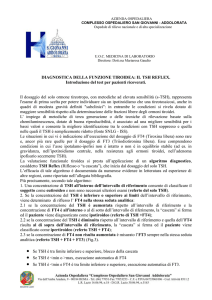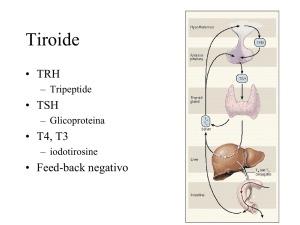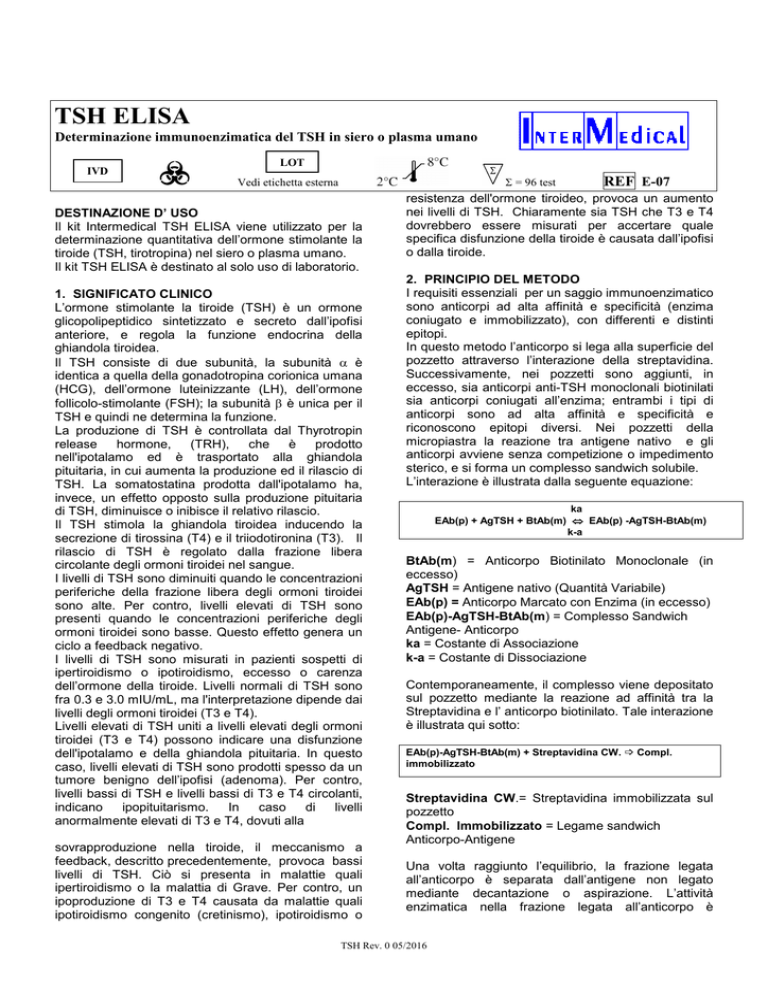
TSH ELISA
Determinazione immunoenzimatica del TSH in siero o plasma umano
IVD
LOT
Σ = 96 test
Vedi etichetta esterna
DESTINAZIONE D’ USO
Il kit Intermedical TSH ELISA viene utilizzato per la
determinazione quantitativa dell’ormone stimolante la
tiroide (TSH, tirotropina) nel siero o plasma umano.
Il kit TSH ELISA è destinato al solo uso di laboratorio.
1. SIGNIFICATO CLINICO
L’ormone stimolante la tiroide (TSH) è un ormone
glicopolipeptidico sintetizzato e secreto dall’ipofisi
anteriore, e regola la funzione endocrina della
ghiandola tiroidea.
Il TSH consiste di due subunità, la subunità α è
identica a quella della gonadotropina corionica umana
(HCG), dell’ormone luteinizzante (LH), dell’ormone
follicolo-stimolante (FSH); la subunità β è unica per il
TSH e quindi ne determina la funzione.
La produzione di TSH è controllata dal Thyrotropin
release
hormone,
(TRH),
che
è
prodotto
nell'ipotalamo ed è trasportato alla ghiandola
pituitaria, in cui aumenta la produzione ed il rilascio di
TSH. La somatostatina prodotta dall'ipotalamo ha,
invece, un effetto opposto sulla produzione pituitaria
di TSH, diminuisce o inibisce il relativo rilascio.
Il TSH stimola la ghiandola tiroidea inducendo la
secrezione di tirossina (T4) e il triiodotironina (T3). Il
rilascio di TSH è regolato dalla frazione libera
circolante degli ormoni tiroidei nel sangue.
I livelli di TSH sono diminuiti quando le concentrazioni
periferiche della frazione libera degli ormoni tiroidei
sono alte. Per contro, livelli elevati di TSH sono
presenti quando le concentrazioni periferiche degli
ormoni tiroidei sono basse. Questo effetto genera un
ciclo a feedback negativo.
I livelli di TSH sono misurati in pazienti sospetti di
ipertiroidismo o ipotiroidismo, eccesso o carenza
dell’ormone della tiroide. Livelli normali di TSH sono
fra 0.3 e 3.0 mIU/mL, ma l'interpretazione dipende dai
livelli degli ormoni tiroidei (T3 e T4).
Livelli elevati di TSH uniti a livelli elevati degli ormoni
tiroidei (T3 e T4) possono indicare una disfunzione
dell'ipotalamo e della ghiandola pituitaria. In questo
caso, livelli elevati di TSH sono prodotti spesso da un
tumore benigno dell’ipofisi (adenoma). Per contro,
livelli bassi di TSH e livelli bassi di T3 e T4 circolanti,
indicano
ipopituitarismo.
In
caso
di
livelli
anormalmente elevati di T3 e T4, dovuti alla
sovrapproduzione nella tiroide, il meccanismo a
feedback, descritto precedentemente, provoca bassi
livelli di TSH. Ciò si presenta in malattie quali
ipertiroidismo o la malattia di Grave. Per contro, un
ipoproduzione di T3 e T4 causata da malattie quali
ipotiroidismo congenito (cretinismo), ipotiroidismo o
REF E-07
resistenza dell'ormone tiroideo, provoca un aumento
nei livelli di TSH. Chiaramente sia TSH che T3 e T4
dovrebbero essere misurati per accertare quale
specifica disfunzione della tiroide è causata dall’ipofisi
o dalla tiroide.
2. PRINCIPIO DEL METODO
I requisiti essenziali per un saggio immunoenzimatico
sono anticorpi ad alta affinità e specificità (enzima
coniugato e immobilizzato), con differenti e distinti
epitopi.
In questo metodo l’anticorpo si lega alla superficie del
pozzetto attraverso l’interazione della streptavidina.
Successivamente, nei pozzetti sono aggiunti, in
eccesso, sia anticorpi anti-TSH monoclonali biotinilati
sia anticorpi coniugati all’enzima; entrambi i tipi di
anticorpi sono ad alta affinità e specificità e
riconoscono epitopi diversi. Nei pozzetti della
micropiastra la reazione tra antigene nativo e gli
anticorpi avviene senza competizione o impedimento
sterico, e si forma un complesso sandwich solubile.
L’interazione è illustrata dalla seguente equazione:
ka
EAb(p) + AgTSH + BtAb(m) ⇔ EAb(p) -AgTSH-BtAb(m)
k-a
BtAb(m) = Anticorpo Biotinilato Monoclonale (in
eccesso)
AgTSH = Antigene nativo (Quantità Variabile)
EAb(p) = Anticorpo Marcato con Enzima (in eccesso)
EAb(p)-AgTSH-BtAb(m) = Complesso Sandwich
Antigene- Anticorpo
ka = Costante di Associazione
k-a = Costante di Dissociazione
Contemporaneamente, il complesso viene depositato
sul pozzetto mediante la reazione ad affinità tra la
Streptavidina e l’ anticorpo biotinilato. Tale interazione
è illustrata qui sotto:
EAb(p)-AgTSH-BtAb(m) + Streptavidina CW.
immobilizzato
Compl.
Streptavidina CW.= Streptavidina immobilizzata sul
pozzetto
Compl. Immobilizzato = Legame sandwich
Anticorpo-Antigene
Una volta raggiunto l’equilibrio, la frazione legata
all’anticorpo è separata dall’antigene non legato
mediante decantazione o aspirazione. L’attività
enzimatica nella frazione legata all’anticorpo è
TSH Rev. 0 05/2016
direttamente proporzionale alla concentrazione
dell’antigene nativo libero.
L’attività dell’enzima è quantificata mediante una
reazione con un substrato che produce una
colorazione.
Utilizzando diversi calibratori a concentrazione nota di
antigene, è possibile tracciare una curva doserisposta, da cui si può determinare la concentrazione
incognita dell’antigene.
•
3. REATTIVI, MATERIALI E STRUMENTAZIONE
•
3.1. Reattivi e materiali forniti nel kit
1. Calibrators (7 flaconi, 1 mL ciascuno)
2. Control (1 flacone, 1 mL)
La concentrazione del Controllo è Lotto-specifica ed è
indicata nel Certificato di Analisi
3. Conjugate (1 flacone, 13 mL)
Anticorpo goat anti TSH coniugato a perossidasi di
rafano (HRP)
Anticorpo mouse anti TSH biotinilato
4. Coated Microplate (1 micropiastra breakable)
Micropiastra coattata con streptavidina
5. TMB Substrate (1 flacone, 15 mL)
H2O2-TMB (0,26 g/L) (evitare il contatto con la pelle)
6. Stop Solution (1 flacone, 15 mL)
Acido Solforico 0,15 mol/L (evitare il contatto con la
pelle)
7. 50X Conc. Wash Solution (1 flacone, 20 mL)
NaCl 45 g/L, Tween-20 55 g/L
3.2. Reattivi necessari non forniti nel kit
Acqua distillata.
3.3. Materiale e strumentazione ausiliare
Dispensatori automatici.
Lettore per micropiastre (450 nm, 620-630 nm).
Note
Conservare tutti i reattivi a 2÷8°C, al riparo dalla
luce. Aprire la busta del Reattivo 4 (Coated
Microplate) solo dopo averla riportata a temperatura
ambiente e chiuderla subito dopo il prelievo delle
strip da utilizzare. Una volta aperta la micropiastra è
stabile fino alla data di scadenza del kit.
4. AVVERTENZE
• Questo test kit è per uso in vitro, da eseguire da
parte di personale esperto. Non per uso interno o
esterno su esseri Umani o Animali.
• Usare i previsti dispositivi di protezione individuale
mentre si lavora con i reagenti forniti.
• Seguire le Buone Pratiche di Laboratorio (GLP)
per la manipolazione di prodotti derivati da
sangue.
• Alcuni reagenti contengono piccole quantità di
Proclin 300R come conservante. Evitare il contatto
con la pelle e le mucose.
•
•
Il TMB Substrato contiene un irritante, che può
essere dannoso se inalato, ingerito o assorbito
attraverso la cute. Per prevenire lesioni, evitare
l’inalazione, l’ingestione o il contatto con la cute e
con gli occhi.
La Stop Solution è costituita da una soluzione di
acido solforico diluito. L’acido solforico è velenoso
e corrosivo e può essere tossico se ingerito. Per
prevenire possibili ustioni chimiche, evitare il
contatto con la cute e con gli occhi.
Evitare l’esposizione del reagente TMB/H2O2 a
luce solare diretta, metalli o ossidanti. Non
congelare la soluzione.
Questo metodo consente di determinare
concentrazioni di TSH da 0,2 a 20,0 mIU/L.
5. PRECAUZIONI
• Si prega di attenersi rigorosamente alla sequenza
dei passaggi indicata in questo protocollo. I
risultati presentati qui sono stati ottenuti usando
specifici reagenti elencati in queste Istruzioni per
l’Uso.
• Tutti i reattivi devono essere conservati a
temperatura controllata di 2-8°C nei loro
contenitori originali. Eventuali eccezioni sono
chiaramente indicate. I reagenti sono stabili fino
alla data di scadenza se conservati e trattati
seguendo le istruzioni fornite.
• Prima dell’uso lasciare tutti i componenti dei kit e i
campioni a temperatura ambiente (22-28°C) e
mescolare accuratamente.
• Non scambiare componenti dei kit di lotti diversi.
Devono essere osservate le date di scadenza
riportate sulle etichette della scatola e di tutte le
fiale. Non utilizzare componenti oltre la data di
scadenza.
• Qualora si utilizzi strumentazione automatica, è
responsabilità dell’utilizzatore assicurarsi che il kit
sia stato opportunamente validato.
• Un lavaggio incompleto o non accurato dei
pozzetti può causare una scarsa precisione e/o
un’elevato background.
• Per la riproducibilità dei risultati, è importante che
il tempo di reazione di ogni pozzetto sia lo stesso.
Per evitare il time shifting durante la
dispensazione degli reagenti, il tempo di
dispensazione dei pozzetti non dovrebbe
estendersi oltre i 10 minuti. Se si protrae oltre, si
raccomanda di seguire lo stesso ordine di
dispensazione. Se si utilizza più di una piastra, si
raccomanda di ripetere la curva di calibrazione in
ogni piastra.
• L’aggiunta del TMB Substrato dà inizio ad una
reazione cinetica, la quale termina con l’aggiunta
della Stop Solution. L’aggiunta del TMB Substrato
e della Stop Solution deve avvenire nella stessa
sequenza per evitare tempi di reazione differenti.
• Osservare le linee guida per l’esecuzione del
controllo di qualità nei laboratori clinici testando
controlli e/o pool di sieri.
• Osservare
la
massima
precisione
nella
ricostituzione e dispensazione dei reagenti.
TSH Rev. 0 05/2016
•
•
Non
usare
campioni
microbiologicamente
contaminati, altamente lipemici o emolizzati.
I lettori di micropiastre leggono l’assorbanza
verticalmente. Non toccare il fondo dei pozzetti.
6. PROCEDIMENTO
6.2. Preparazione della Wash Solution
Prima dell’uso, diluire il contenuto di ogni fiala di "50X
Conc. Wash Solution" con acqua distillata fino al
volume di 1000 mL. Per preparare volumi minori
rispettare il rapporto di diluizione di 1:50. La soluzione
di lavaggio diluita è stabile a 2÷8°C per almeno 30
giorni.
6.3. Preparazione del campione
La determinazione del TSH può essere effettuata su
siero o plasma umano.
Il campione può essere conservato a 2-8°C per
massimo due giorni. Per lunghi periodi di stoccaggio i
campioni dovrebbero essere congelati. I campioni
congelati devono essere agitate bene dopo lo
scongelamento e prima del dosaggio. Evitare ripetuti
cicli di congelamento/scongelamento.
Per campioni con concentrazione superiore a 20
mIU/L diluite il campione 1:2 con il Calibratore 0.
Correggere il risultato usando l’appropriato fattore di
diluizione.
Il Controllo è pronto all'uso.
•
•
•
Calibratore
C0-C6
Calibratore
6.4. Procedimento
Portare tutti i reagenti a temperatura ambiente
(22-28°C) per almeno 30 minuti. Al termine del
dosaggio riporre immediatamente tutti i reagenti a
2-8°C: evitare lunghi periodi a temperatura
ambiente.
Le strisce di pozzetti non utilizzate devono essere
rimesse immediatamente nella busta richiudibile
contenente il materiale essicante e conservate a
2-8°C.
Per evitare potenziali contaminazioni microbiche
e/o chimiche non rimettere i reagenti inutilizzati nei
flaconi originali.
Al fine di aumentare l’accuratezza dei risultati del
test è necessario operare in doppio, allestendo
due pozzetti per ogni punto della curva di
calibrazione (C0-C6), due per ogni Controllo, due
per ogni Campione ed uno per il Bianco.
Conjugate
Campione
/Controllo
Bianco
50 µL
Campione
/Controllo
6.1. Preparazione dei Calibratori (C0…C6)
I Calibratori sono pronti all'uso, sono calibrati contro il
WHO 2nd IRP 80/558 ed hanno le seguenti
concentrazioni:
C1
C2
C3
C4
C5
C6
C0
mIU/L
0
0,2
0,5
2,5
5,0
10
20
I Calibratori sono stabili fino alla data di scadenza
riportata in etichetta. Una volta aperti, i Calibratori
sono stabili sei mesi a 2-8°C.
•
Reagente
50 µL
100 µL
100 µL
Coprire la piastra e incubare per 60 minuti a
temperatura ambiente (22÷28°C). Per incrementare
la sensibilità prolungare il tempo di incubazione a
120 minuti.
Allontanare la miscela di reazione; lavare i pozzetti
per 6 volte con 300 µL di Wash Solution diluita.
Nota importante: ad ogni step di lavaggio, agitare
delicatamente la piastra per 5 secondi e
successivamente rimuovere l'eccesso di soluzione
di lavaggio sbattendo delicatamente la micropiastra
capovolta su fogli di carta assorbente.
TMB
Substrate
100 µL
100 µL
100 µL
Coprire la piastra ed incubare 20 minuti a
temperatura ambiente (22÷28°C) al riparo dalla luce.
Stop
Solution
100 µL
100 µL
100 µL
Agitare delicatamente la micropiastra.
Leggere l’assorbanza (E) a 450 nm contro una
lunghezza d'onda di riferimento di 620-630 nm
oppure contro il Bianco entro 5 minuti.
7. CONTROLLO QUALITA’
Ogni laboratorio dovrebbe analizzare i campioni nella
gamma dei livelli elevati, normali e bassi di TSH per il
controllo delle prestazioni dell’analisi. Questi campioni
dovrebbero essere trattati come ignoti ed i valori
determinati in ogni test effettuato. Le tabelle di
controllo qualità dovrebbero essere effettuate per
seguire le prestazioni dei reagenti forniti. Metodi
statistici adeguati dovrebbero essere impiegati per
accertare il trend. Il laboratorio dovrebbe fissare i
limiti di accettabilità di prestazioni dell’analisi. In più, la
capacità di assorbimento massima dovrebbe essere
costante con l’esperienza precedente. Deviazioni
significative rispetto alle prestazioni stabilite possono
indicare un inosservato cambio di condizioni
sperimentali o una degradazione dei reagenti kit.
Devono essere usati reagenti freschi per determinare
la ragione delle variazioni.
8. RISULTATI
8.1. Estinzione Media
Calcolare l’estinzione media (Em) di ciascun punto
della curva di calibrazione (C0-C6) e di ogni campione.
8.2. Curva di calibrazione
Tracciare sul grafico delle assorbanze i valori calcolati
delle estinzioni medie (Em) di ciascun Calibratore (C0
-C6) in funzione delle concentrazioni.
TSH Rev. 0 05/2016
Tracciare la miglior curva passante per i punti di
calibrazione (es: Cubic Spline o Four Parameter
Logistic).
8.3. Calcolo dei risultati
Interpolare i risultati sul grafico, leggendo i valori di
concentrazione in mIU/L corrispondenti alle
assorbanze di ciascun campione sulla curva
disegnata.
9. VALORI DI RIFERIMENTO
Campioni di siero di donne e uomini sani sono stati
saggiati utilizzando il Intermedical TSH ELISA test,
con i seguenti risultati:
TSH
Media (mIU/L)
1,85
Range (mIU/L)
0,39 – 6,16
È importante tenere presente che la determinazione
di un range di valori attesi in un dato metodo per una
popolazione “normale” è dipendente da molteplici
fattori, quali la specificità e sensibilità del metodo in
uso, e la popolazione in esame. Perciò ogni
laboratorio dovrebbe considerare i range indicati dal
Fabbricante come un’indicazione generale e produrre
range di valori attesi propri basati sulla popolazione
indigena dove il laboratorio risiede.
10. PARAMETRI CARATTERISTICI
10.1. Precisione
10.1.1. Intra-Assay
La variabilità all’interno dello stesso kit è stata
determinata replicando (16x) la misura di due
differenti sieri di controllo. La variabilità intra-assay è
≤ 4,6%.
10.1.2. Inter-Assay
La variabilità tra kit differenti è stata determinata
replicando (12x) la misura di tre differenti sieri di
controllo con kit appartenenti a lotti diversi. La
variabilità inter-assay è ≤ 10,8%.
10.2. Accuratezza
La prova di recupero condotta su campioni arricchiti
con 0,25 – 2,5 – 10 mIU/L di TSH, ha dato un valore
medio (±SD) di 88,85% ± 2,62%.
Tirotropina (hTSH)
Tirotropina - alpha (hTSH-α)
Tirotropina - beta (hTSH-β)
Follitropina (hFSH)
Ormone luteinizzante(hLH)
GonadotropinaCorionica(hCG)
100 %
9,3 %
152 %
1,0 %
1,0 %
<0,1 %
10.5. Correlazione con altri dosaggi
Il kit Intermedical TSH ELISA è stato comparato con
due diversi kits disponibili in commercio. Sono stati
testati 54 campioni di siero. Le curve di regressione
sono:
(TSH Intermedical) = 0,96*(TSH CLIA)+0,06
r2 = 0,972
(TSH Intermedical) = 0,87*(TSH Elisa) + 0,29
r2 = 0,971
10.6. Effetto “Hook”
In questo metodo non è stato osservato effetto Hook
fino a 500 mIU/L.
11. DISPOSIZIONI PER LO SMALTIMENTO
I reagenti devono essere smaltiti in accordo con le
leggi locali.
BIBLIOGRAFIA
1. Hopton M. R, et al Clinical Chemistry, 32, 691
(1986)
2. Caldwell, G. et al. Lancet, I, 1117, (1985)
3. Young, D. S, et al Clinical Chemistry 21, 3660
(1975)
4. Spencer, CA, et al Clinical Chemistry 41, 367
(1995)
5. Beck-Peccoz P, et al Eur. J. Endocrinol 131: 331340 (1994)
6. Bravemann, L. E, Clinical Chemistry 42: 174-181
(1996)
7. Fisher, D. A., Clinical Chemistry 42: 135-139
(1996)
Contatti:
InterMedical S.r.l. Via A.Genovesi,13
10.3. Sensibilità
La concentrazione minima di TSH misurabile che può
essere distinta dal Calibratore 0 è 0,01 mIU/L con un
limite di confidenza del 95%.
10.4. Specificità
La cross-reattività della tirotropina ELISA verso
sostanze selezionate è stata valutata aggiungendo
sostanze interferenti al siero a concentrazioni
differenti. La cross-reattività è stata calcolata
mediante il rapporto tra la dose della sostanza
interferente e la quantità di TSH necessaria a dare la
stessa assorbanza.
TSH Rev. 0 05/2016
80010 Villaricca (NA)
ITALY - Tel. +39 81 330 27 05 Fax +39 81 330 14 53
P. IVA 03426331215
e-mail product specialist :
[email protected]
Fabbricante
INTERMEDICAL s.r.l.
Via A. Genovesi,13
80010 Villaricca(Na)-ITALY
TSH ELISA
Direct immunoenzymatic determination of TSH in human serum or plasma
LOT
IVD
Σ = 96 tests
See external label
INTENDED USE
Intermedical TSH ELISA is an immunoenzymatic
colorimetric method for quantitative determination of
thyroid-stimulating hormone (TSH, thyrotropin)
concentration in human serum or plasma.
TSH ELISA kit is intended for laboratory use only.
1. CLINICAL SIGNIFICANCE
Thyroid-stimulating hormone (TSH or thyrotropin) is a
glycopolipeptide hormone synthesized and secreted
by the anterior pituitary gland which regulates the
endocrine function of the thyroid gland.
TSH consists of two subunits, the alpha and the beta
subunit. The α subunit is identical to that of human
chorionic gonadotropin (HCG), luteinising hormone
(LH), follicle-stimulating hormone (FSH). The β (beta)
subunit is unique to TSH, and therefore determines
its function.
TSH production is controlled by a Thyrotropin
Releasing Hormone, (TRH), which is manufactured in
the hypothalamus and transported to the pituitary
gland, where it increases TSH production and
release. Somatostatin is also produced by the
hypothalamus, and has an opposite effect on the
pituitary production of TSH, decreasing or inhibiting
its release.
TSH stimulates the thyroid gland to secrete the
hormones thyroxine (T4) and triiodothyronine (T3).
Release of TSH is regulated by the circulating free
fraction of thyroid hormones in the blood. TSH levels
are depressed when peripheral concentrations of the
free fraction of thyroid hormones are high.
Conversely, TSH levels are high when peripheral
concentrations of thyroid hormones are low. This
effect creates a regulatory negative feedback loop.
TSH levels are tested in the blood of patients
suspected of suffering from excess (hyperthyroidism),
or deficiency (hypothyroidism) of thyroid hormone.
Generally, a normal range for TSH is between 0.3
and 3.0 mIU/mL, but the interpretation depends also
on what the blood levels of thyroid hormones (T3 and
T4) are.
Higher than normal levels of TSH combined with high
levels of thyroid hormone (T3 and T4) may indicate
dysfunction of the hypothalamus and pituitary gland.
In these case, a high TSH is often produced by a
benign tumour of the pituitary (adenoma).
Conversely, low levels of TSH, while blood levels of
T3 and T4 are also low, indicates abnormally low
function of the pituitary, known as hypopituitarism.
On the other hand, due to the negative feedback
described above, abnormally high levels of Thyroid
hormone, due to overproduction in the thyroid, results
REF E-07
in low TSH levels. This occurs in diseases such as
hyperthyroidism or Grave’s disease. Conversely, an
underproduction of T3 and T4 caused by diseases
such as congenital hypothyroidism (cretinism),
hypothyroidism or thyroid hormone resistance, gives
rise to an increase in the measured TSH.
Clearly both TSH and T3 and T4 should be measured
to ascertain where a specific thyroid disfunction is
caused by primary pituitary or by a primary thyroid
disease.
2. PRINCIPLE
The
essential
reagents
required
for
an
immunoenzymatic assay include high affinity and
specificity antibodies (enzyme and immobilised) with
different and distinct epitope recognition, in excess,
and native antigen.
In this method, TSH calibrators, patient specimens
and/or controls containing the native antigen are first
added to streptavidin coated wells.
Byotinilated
monoclonal and enzyme labeled antibodies are
added and the reactants mixed : these antibodies
have high affinity and specificity and are detected
against distinct and different epitopes of TSH.
Reaction between the various TSH antibodies and
native TSH occurs in the microwells without
competition or steric hindrance forming a soluble
sandwich complex.
The interaction is illustrated by the following equation:
ka
EAb(p) + AgTSH + BtAb(m) ⇔ EAb(p) -AgTSH-BtAb(m)
k-a
BtAb(m) = Byotinilated Monoclonal Antibody (Excess
Quantity)
AgTSH = Native Antigen (Variable Quantity)
EAb(p) = Enzyme labeled Antibody (Excess Quantity)
EAb(p)-AgTSH-BtAb(m) = Antigen-Antibodies
Sandwich Complex
Ka = Rate Constant of Association
K-a = Rate Constant of Dissociation
Simultaneously, the complex is deposited to the well
though the high affinity reaction of streptavidin and
biotinylated antibody. This interaction is illustrated
below:
EAb(p)-AgTSH-BtAb(m) + Streptavidina CW.
Complex
Immobilized
Streptavidin CW. = Streptavidin immobilized on well
Immobilized
Complex
=
Antibodies-Antigen
sandwich bound.
TSH Rev. 0 05/2016
•
After equilibrium is attained, the antibody-bound
fraction is separated from unbound antigen by
decantation or aspiration. The enzyme activity in the
antibody bound fraction is directly proportional to the
native antigen concentration. The activity of the
enzyme present on the surface of the well is
quantified by reaction with a suitable substrate to
produce colour. By utilizing several different
calibrators of know antigen values, a dose response
curve can be generated from which the antigen
concentration of an unknown can be ascertained.
•
•
•
The TMB Substrate contains an irritant, which may
be harmful if inhaled, ingested or absorbed
through the skin. To prevent injury, avoid
inhalation, ingestion or contact with skin and eyes.
The Stop Solution consists of a diluted sulphuric
acid solution. Sulphuric acid is poisonous and
corrosive and can be toxic if ingested. To prevent
chemical burns, avoid contact with skin and eyes.
Avoid the exposure of reagent TMB/H2O2 to
directed sunlight, metals or oxidants. Do not
freeze the solution.
This method allows the determination of TSH from
0.2 mIU/L to 20.0 mIU/L.
3. REAGENTS, MATERIALS AND INSTRUMENTATION
5.
3.1. Reagents and materials supplied in the kit
1. Calibrators (7 vials, 1 mL each)
2. Control (1 vial, 1 mL)
Concentration of Control is Lot-specific and is
indicated on the Certificate of Analysis
3. Conjugate (1 vial, 13 mL)
Goat antibody anti TSH conjugated with horseradish
peroxidase HRP
Mouse antibody anti TSH biotinylated
•
•
•
•
4. Coated Microplate (1 breakable microplate)
Microplate coated with streptavidin
5. TMB Substrate (1 vial, 15 mL)
H2O2-TMB 0.26 g/L (avoid any skin contact)
•
6. Stop Solution (1 vial, 15 mL)
Sulphuric acid 0.15 mol/L (avoid any skin contact)
•
7. 50X Conc. Wash Solution (1 vial, 20 mL)
NaCl 45 g/L, Tween-20 55 g/L
•
3.2.
Reagents necessary not supplied
Distilled water.
3.3.
Auxiliary materials and instrumentation
Automatic dispenser.
Microplates reader (450 nm, 620-630 nm).
Note
Store all reagents between 2÷8°C in the dark.
Open the bag of reagent 4 (Coated Microplate) only
when it is at room temperature and close
immediately after use. Once opened, the microplate
is stable until expiry date of the kit.
4. WARNINGS
This kit is intended for in vitro use by professional
persons only. Not for internal or external use in
Humans or Animals.
• Use appropriate personal protective equipment
while working with the reagents provided.
• Follow Good Laboratory Practice (GLP) for
handling blood products.
• Some reagents contain small amounts of Proclin
300R as preservative. Avoid the contact with skin
or mucosa.
•
•
•
•
•
•
PRECAUTIONS
Please adhere strictly to the sequence of pipetting
steps provided in this protocol. The performance
data represented here were obtained using
specific reagents listed in this Instruction For Use.
All reagents should be stored refrigerated at 2-8°C
in their original container. Any exceptions are
clearly indicated. The reagents are stable until the
expiry date when stored and handled as indicated.
Allow all kit components and specimens to reach
room temperature (22-28°C) and mix well prior to
use.
Do not interchange kit components from different
lots. The expiry date printed on box and vials
labels must be observed. Do not use any kit
component beyond their expiry date.
If you use automated equipment, the user has the
responsibility to make sure that the kit has been
appropriately tested.
The incomplete or inaccurate liquid removal from
the wells could influence the assay precision
and/or increase the background.
It is important that the time of reaction in each well
is held constant for reproducible results. Pipetting
of samples should not extend beyond ten minutes
to avoid assay drift. If more than 10 minutes are
needed, follow the same order of dispensation. If
more than one plate is used, it is recommended to
repeat the dose response curve in each plate
Addition of the TMB Substrate solution initiates a
kinetic reaction, which is terminated by the
addition of the Stop Solution. Therefore, the TMB
Substrate and the Stop Solution should be added
in the same sequence to eliminate any time
deviation during the reaction.
Observe the guidelines for performing quality
control in medical laboratories by assaying
controls and/or pooled sera.
Maximum precision is required for reconstitution
and dispensation of the reagents.
Samples microbiologically contaminated, highly
lipemeic or haemolysed should not be used in the
assay.
Plate readers measure vertically. Do not touch the
bottom of the wells.
TSH Rev. 0 05/2016
Reagent
6. PROCEDURE
6.1. Preparation of the Calibrators (C0…C6)
The Calibrators are ready to use, are calibrated
against WHO 2nd IRP 80/558 and have the following
concentrations of TSH:
C0
C1
C2
C3
C4
C5
C6
mIU/L
0
0.2
0.5
2.5
5.0
10
20
The Calibrators are stable until the expiry date printed
on the label. Once opened, the calibrators are stable six
months at 2-8°C.
6.2. Preparation of Wash Solution
Dilute the contents of each vial of the "50X Conc.
Wash Solution" with distilled water to a final volume
of 1000 mL prior to use. For smaller volumes respect
the 1:50 dilution ratio. The diluted wash solution is
stable for 30 days at 2÷8°C.
6.3. Preparation of the Sample
TSH assay can be performed in human serum or
plasma.
Specimens may be stored at 2÷8°C for maximum two
days. For longer storage, specimens should be
frozen. Frozen specimens should be well mixed after
thawing, and before assay. Avoid repeated freezing
and thawing.
Serum samples with TSH concentrations greater than
20mIU/L should be diluted 1:2 with C0. Correct the
result using an appropriate dilution factor.
The Control is ready to use.
6.4.
Procedure
Allow all reagents to reach room temperature
(22-28°C) for at least 30 minutes. At the end of
the assay, store immediately the reagents at 28°C: avoid long exposure to room temperature.
• Unused coated microwell strips should be
released securely in the foil pouch containing
desiccant and stored at 2-8°C.
• To avoid potential microbial and/or chemical
contamination, unused reagents should never be
transferred into the original vials.
• As it is necessary to perform the determination in
duplicate in order to improve accuracy of the test
results, prepare two wells for each point of the
calibration curve (C0-C6), two for each Control, two
for each sample, one for Blank.
•
Calibrator
C0-C6
Calibrator
Blank
50 µL
Sample/
Control
Conjugate
Sample/
Control
50 µL
100 µL
100 µL
Cover the plate and incubate for 60 minutes at room
temperature (22÷28°C). To increase the sensibility
read the absorbance after 120 min of incubation.
Remove the content from each well; wash the wells 6
times with 300 µL of diluted Wash Solution.
Important note: during each washing step, gently
shake the plate for 5 seconds and remove excess
solution by tapping the inverted plate on an absorbent
paper towel.
TMB
Substrate
100 µL
100 µL
100 µL
Cover the plate and incubate for 20 minutes at room
temperature (22÷28°C) in the dark.
Stop
Solution
100 µL
100 µL
100 µL
Shake the plate gently.
Read the absorbance (E) at 450 nm against a
reference wavelength of 620-630 nm or against
Blank within 5 minutes.
7. QUALITY CONTROL
Each laboratory should assay controls at normal, high
and low levels range of TSH for monitoring assay
performance. These controls should be treated as
unknowns and values determined in every test
procedure performed. Quality control charts should
be maintained to follow the performance of the
supplied reagents. Pertinent statistical methods
should be employed to ascertain trends. The
individual laboratory should set acceptable assay
performance limits.In addition, maximum absorbance
should be consistent with past experience. Significant
deviation from established performance can indicate
unnoticed change in experimental conditions or
degradation of kit reagents. Fresh reagents should
be used to determine the reason for the variations.
8. RESULTS
8.1. Mean Absorbance
Calculate the mean of the absorbance (Em) for each
point of the calibration curve (C0-C6) and of each
sample.
8.2. Calibration curve
Plot the mean value of absorbance (Em) of the
calibrators (C0-C6) against concentration. Draw the
best-fit curve through the plotted points. (es:Cubic
Spline or Four Parameter Logistic).
TSH Rev. 0 05/2016
8.3. Calculation of Results
Interpolate the values of the samples on the
calibration curve to obtain the corresponding values of
the concentrations expressed in mIU/L.
9. REFERENCE VALUES
Serum samples of apparently healthy women and
men were assayed using the TSH ELISA test, with
the following results:
TSH
Mean (mIU/L)
1.85
Range (mIU/L)
0.39 – 6.16
Please pay attention to the fact that the determination
of a range of expected values for a “normal”
population in a given method is dependent on many
factors, such as specificity and sensitivity of the
method used and type of population under
investigation. Therefore each laboratory should
consider the range given by the Manufacurer as a
general indication and produce their own range of
expected values based on the indigenous population
where the laboratory works.
10. PERFORMANCE AND CHARACTERISTICS
10.1. Precision
10.1.1. Intra Assay Variation
Within run variation was determined by replicate
measurements (16x) of two different control sera in
one assay. The within assay variability is ≤ 4.6%.
10.1.2. Inter Assay Variation
Between run variation was determined by replicate
measurements (12x) of three different control sera in
different lots of kit. The between assay variability is ≤
10.8%.
10.2. Accuracy
The recovery of 0.25 – 2.5 – 10 mIU/L of TSH added
to sample gave an average value (±SD) of 85.85% ±
2.62% with reference to the original concentrations.
10.5. Correlation with CLIA
Intermedical TSH ELISA was compared with two
others commercially available TSH assays. 54 serum
samples were tested.
The two linear regression curves were calculated:
(TSH Intermedical) = 0.96*(TSH CLIA)+0.06
r2 = 0.972
(TSH Intermedical) = 0.87*(TSH Elisa) + 0.29
r2 = 0.971
10.6. Hook Effect
Intermedical TSH ELISA, a competitive enzyme
immunoassay, shows no Hook Effect up to 500
mIU/L.
11. WASTE MANAGEMENT
Reagents must be disposed off in accordance with
local regulations.
BIBLIOGRAPHY
1. Hopton M. R, et al Clinical Chemistry, 32, 691
(1986)
2. Caldwell, G. et al. Lancet, I, 1117, (1985)
3. Young, D. S, et al Clinical Chemistry 21, 3660
(1975)
4. Spencer, CA, et al Clinical Chemistry 41, 367
(1995)
5. Beck-Peccoz P, et al Eur. J. Endocrinol 131: 331340 (1994)
6. Bravemann, L. E, Clinical Chemistry 42: 174-181
(1996)
7. Fisher, D. A., Clinical Chemistry 42: 135-139
(1996)
Contact:
InterMedical S.r.l. Via A.Genovesi,13
10.3. Sensitivity
The lowest detectable concentration of TSH that can
be distinguished from the Calibrator 0 is 0.01 mIU/L
with a confidence limit of 95%.
10.4. Specificity
The cross-reactivity of the thyrotropin ELISA method
to selected substances was evaluated by adding the
interfering substance to a serum matrix at various
concentrations. The cross-reactivity was calculated
Thyrotropin (hTSH)
Thyrotropin - alpha (hTSH-α)
Thyrotropin - beta (hTSH-β)
Follicle-Stimulating Hormone (hFSH)
Luteinising hormone (hLH)
Chorionic Gonadotropin (hCG)
100 %
9.3 %
152 %
1.0 %
1.0 %
<0.1 %
TSH Rev. 0 05/2016
80010 Villaricca (NA)
ITALY - Tel. +39 81 330 27 05 Fax +39 81 330 14 53
P. IVA 03426331215
e-mail product specialist :
[email protected]
Fabbricante
INTERMEDICAL s.r.l.
Via A. Genovesi,13
80010 Villaricca(Na)-ITALY
INTERMEDICAL SRL
PACKAGING INFORMATION SHEET
IT
Spiegazione dei simboli
DE
FR
ES
Explication des symboles
Significado de los simbolos
PT
Verwendete Symbole
REF
yyyy-mm-dd
Σ = xx
Max
Min
GB
Explanation of symbols
Explicaçao dos simbolos
DE
ES
FR
GB
IT
PT
In vitro Diagnostikum
Producto sanitario para diagnóstico In vitro
Dispositif medical de diagnostic in vitro
In vitro Diagnostic Medical Device
Dispositivo medico-diagnostico in vitro
Dispositivos medicos de diagnostico in vitro
DE
ES
FR
GB
IT
PT
Hergestellt von
Elaborado por
Fabriqué par
Manufacturer
Produttore
Produzido por
DE
ES
FR
GB
IT
PT
Bestellnummer
Nûmero de catálogo
Réferéncès du catalogue
Catalogue number
Numero di Catalogo
Número do catálogo
DE
ES
FR
GB
IT
PT
Herstellungs datum
Fecha de fabricacion
Date de fabrication
Date of manufacture
Data di produzione
Data de produção
DE
ES
FR
GB
IT
PT
Verwendbar bis
Establa hasta (usar antes de último día del mes)
Utiliser avant (dernier jour du mois indiqué)
Use by (last day of the month)
Utilizzare prima del (ultimo giorno del mese)
Utilizar (antes ultimo dia do mês)
DE
ES
FR
GB
IT
PT
Biogefährdung
Riesco biológico
Risque biologique
Biological risk
Rischio biologico
Risco biológico
DE
ES
FR
GB
IT
PT
Gebrauchsanweisung beachten
Consultar las instrucciones
Consulter le mode d’emploi
Consult instructions for use
Consultare le istruzioni per l’uso
Consultar instruções para uso
DE
ES
FR
GB
IT
PT
Chargenbezeichnung
Codigo de lote
Numero de lot
Batch code
Codice del lotto
Codigo do lote
DE
ES
FR
GB
IT
PT
Ausreichend für “n” Tests
Contenido suficiente para ”n” tests
Contenu suffisant pour “n” tests
Contains sufficient for “n” tests
Contenuto sufficiente per “n” saggi
Contém o suficiente para “n” testes
DE
ES
FR
GB
IT
PT
Inhalt
Contenido del estuche
Contenu du coffret
Contents of kit
Contenuto del kit
Conteúdo do kit
DE
ES
FR
GB
IT
PT
Temperaturbereich
Límitaciôn de temperatura
Limites de température de conservation
Temperature limitation
Limiti di temperatura
Temperaturas limites de conservação
yyyy-mm
Cont.
INTERMEDICAL SRL
PACKAGING INFORMATION SHEET
SUGGERIMENTI PER LA RISOLUZIONE DEI PROBLEMI/TROUBLESHOOTING
ERRORE CAUSE POSSIBILI/ SUGGERIMENTI
Nessuna reazione colorimetrica del saggio
- mancata dispensazione del coniugato
- contaminazione del coniugato e/o del Substrato
- errori nell’esecuzione del saggio (es. Dispensazione accidentale dei reagenti in sequenza errata o provenienti da
flaconi sbagliati, etc.)
Reazione troppo blanda (OD troppo basse)
- coniugato non idoneo (es. non proveniente dal kit originale)
- tempo di incubazione troppo breve, temperatura di incubazione troppa bassa
Reazione troppo intensa (OD troppo alte)
- coniugato non idoneo (es. non proveniente dal kit originale)
- tempo di incubazione troppo lungo, temperatura di incubazione troppa alta
- qualità scadente dell’acqua usata per la soluzione di lavaggio (basso grado di deionizzazione,)
- lavaggi insufficienti (conjugato non completamente rimosso)
Valori inspiegabilmente fuori scala
- contaminazione di pipette, puntali o contenitori- lavaggi insufficienti (conjugato non completamente rimosso)
CV% intrasaggio elevato
- reagenti e/o strip non portate a temperature ambiente prima dell’uso
- il lavatore per micropiastre non lava correttamente (suggerimento: pulire la testa del lavatore)
CV% intersaggio elevato
- condizioni di incubazione non costanti (tempo o temperatura)
- controlli e campioni non dispensati allo stesso tempo (con gli stessi intervalli) (controllare la sequenza di
dispensazione)
- variabilità intrinseca degli operatori
ERROR POSSIBLE CAUSES / SUGGESTIONS
No colorimetric reaction
- no conjugate pipetted reaction after addition
- contamination of conjugates and/or of substrate
- errors in performing the assay procedure (e.g. accidental pipetting of reagents in a wrong sequence or from the wrong
vial, etc.)
Too low reaction (too low ODs)
- incorrect conjugate (e.g. not from original kit)
- incubation time too short, incubation temperature too low
Too high reaction (too high ODs)
- incorrect conjugate (e.g. not from original kit)
- incubation time too long, incubation temperature too high
- water quality for wash buffer insufficient (low grade of deionization)
- insufficient washing (conjugates not properly removed)
Unexplainable outliers
- contamination of pipettes, tips or containers
insufficient washing (conjugates not properly removed) too high within-run
- reagents and/or strips not pre-warmed to CV% Room Temperature prior to use
- plate washer is not washing correctly (suggestion: clean washer head)
too high between-run - incubation conditions not constant (time, CV % temperature)
- controls and samples not dispensed at the same time (with the same intervals) (check pipetting order)
- person-related variation

